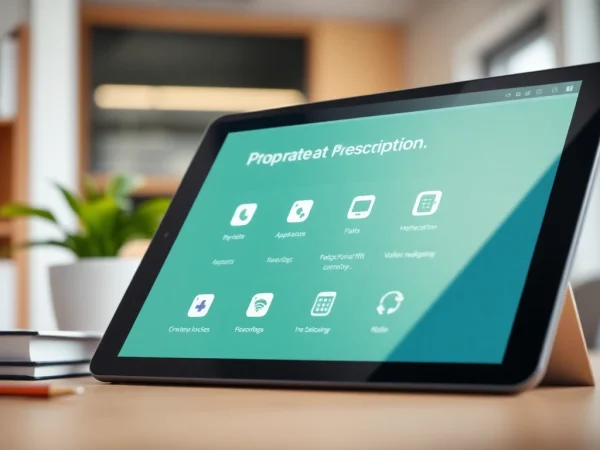Enhancing Patient Safety with Secure Eprescribing Solutions
Understanding Secure Eprescribing Solutions
What are Secure Eprescribing Solutions?
In recent years, the healthcare sector has seen a significant shift towards digital solutions, and one of the most critical innovations in this space is secure eprescribing solutions. These solutions represent a technological advancement that enables healthcare providers to electronically send prescriptions to pharmacies, eliminating the need for paper prescriptions. By leveraging encrypted systems and secure networks, e-prescribing ensures that patient information remains confidential while also enabling faster processing of prescriptions. At its core, secure e-prescribing encompasses compliance with federal and state regulations, utilizing sophisticated technology and robust authentication methods to safeguard sensitive data.
Benefits of Using Secure Eprescribing Solutions
Utilizing secure e-prescribing solutions offers a multitude of advantages for both healthcare providers and patients alike. Some of the most noteworthy benefits include:
- Increased Efficiency: Physicians can send prescriptions directly to the pharmacy in real-time, which reduces wait times for patients and allows for quicker medication dispensing.
- Improved Patient Safety: By minimizing the potential for errors associated with handwritten prescriptions, secure e-prescribing helps ensure that patients receive the correct dosages and medications.
- Enhanced Drug Interaction Checks: Many e-prescribing systems are integrated with clinical decision support tools that alert prescribers about potential drug interactions, contraindications, or allergies.
- Cost Savings: E-prescribing can reduce administrative costs, such as the need for follow-up calls or faxing, making the process more streamlined and cost-effective.
- Regulatory Compliance: Secure e-prescribing adheres to strict regulations, thereby safeguarding sensitive patient information and ensuring compliance with legal requirements.
Key Features to Look for in Eprescribing Solutions
When evaluating potential secure e-prescribing solutions, healthcare providers should consider several critical features that enhance efficiency, security, and usability:
- User-Friendly Interface: A straightforward, intuitive interface allows for easier adoption by healthcare staff.
- Integration Capabilities: The ability to integrate smoothly with existing Electronic Health Records (EHR) systems simplifies workflows and maintains comprehensive patient data.
- Real-Time Drug Interaction Updates: Look for solutions that provide instant alerts for potential drug interactions based on the patient’s medication list.
- Robust Security Measures: Systems should include encryption, two-factor authentication, and secure logging practices to protect patient data.
- Support for Controlled Substances: Solutions must comply with regulations for prescribing controlled medications, including necessary security protocols.
Implementing Secure Eprescribing Solutions
Steps to Integrate Eprescribing Solutions in Your Practice
The successful integration of secure e-prescribing solutions into a healthcare practice involves strategic planning and execution. Here are crucial steps to ensure a smooth implementation:
- Assess Needs: The first step is determining the specific requirements of your practice, including the types of medications prescribed and the volume of prescriptions handled.
- Select the Right Solution: Choose a solution that matches your needs based on the previously identified criteria, considering both current and future goals.
- Establish a Plan: Develop a comprehensive implementation plan outlining timelines, training schedules, and communication strategies to keep all staff informed.
- Staff Training: Conduct thorough training sessions for all users to ensure they are comfortable with the new system and understand its benefits.
- Launch and Monitor: Roll out the e-prescribing solution and monitor its integration carefully, addressing any challenges as they arise to optimize use.
Challenges in Adoption and How to Overcome Them
While the benefits of secure e-prescribing solutions are clear, there are challenges associated with their adoption. Common hurdles include:
- Resistance to Change: Staff members may resist adopting new technology. Overcoming this requires effective communication about the benefits of e-prescribing and involving team members in the selection process.
- Technical Issues: System glitches or incompatibilities with existing infrastructure can disrupt practice workflows. Choosing a reputable vendor that offers robust support can mitigate this risk.
- Compliance Concerns: Navigating the landscape of regulatory compliance can be daunting. Educating staff on legal requirements is essential for fostering adherence.
Training Staff on Secure Eprescribing Solutions
Effective training is pivotal in maximizing the value of secure e-prescribing solutions. Strategies for successful training programs include:
- Hands-On Learning: Provide practical, hands-on training sessions where staff can practice using the software in real-world scenarios.
- Ongoing Support: Implement a robust support system with accessible resources, such as FAQs, how-to guides, and dedicated IT personnel for troubleshooting.
- Feedback Mechanism: Establish channels for staff to provide feedback about their training experience and any difficulties they encounter, allowing for continuous improvement.
Regulatory Compliance for Secure Eprescribing Solutions
Understanding Legal Requirements
Secure e-prescribing solutions must comply with various legal frameworks and regulations governing the handling of patient information. Key regulations include:
- Health Insurance Portability and Accountability Act (HIPAA): This law sets standards for the protection of electronic health information, requiring e-prescribing systems to employ stringent security measures.
- Drug Enforcement Administration (DEA): The DEA mandates specific requirements for electronically prescribing controlled substances, including secure authentication measures and documentation.
- State Regulations: Different states may impose additional requirements for e-prescribing, including rules related to prescription drug monitoring programs.
Best Practices for Meeting Compliance
To ensure compliance with regulatory requirements, practices should adopt the following best practices:
- Regular Training: Offer regular training sessions to keep staff updated on compliance requirements and best practices.
- Audit Trails: Implement systems that maintain thorough documentation and audit trails of every prescription for accountability and compliance verification.
- Conduct Regular Reviews: Engage in periodic reviews of your e-prescribing processes to identify potential compliance gaps and ensure adherence to changing regulations.
Documentation and Audit Trails Explained
Documentation and maintaining audit trails are essential for verifying compliance with legal requirements. Key aspects of effective documentation include:
- Comprehensive Record Keeping: Maintain records of prescriptions, including details on changes, cancellations, and communications with pharmacies.
- Secure Storage: Ensure that all documentation is stored securely to prevent unauthorized access, in compliance with HIPAA regulations.
- Timely Updates: Integrate a system for timely updates to patient records, ensuring that any changes in the patient’s medication are documented reflectively.
Enhancing Security in Eprescribing Solutions
Data Protection Measures for Eprescribing
As digital transformation accelerates, safeguarding sensitive patient information has never been more critical. Implementing robust data protection measures is paramount:
- Encryption: Employ strong encryption methods for all data transmissions to protect against unauthorized access and data breaches.
- Access Controls: Limit access to e-prescribing systems to authorized personnel only, employing role-based access control mechanisms.
- Data Backup: Regularly back up critical data to ensure recoverability in case of system failures or breaches.
Utilizing Authentication and Encryption
Authentication and encryption are the two cornerstones of secure e-prescribing solutions. Consider the following strategies:
- Multi-Factor Authentication: Require multi-factor authentication for all users, ensuring that access to e-prescribing systems is secure and restricted to authorized personnel.
- Regular Security Updates: Stay updated with the latest security protocols and software patches to bolster the resilience of your e-prescribing solution.
- Secure API Integrations: When integrating with other systems, ensure that API connections are secure to prevent data leaks and unauthorized access.
Common Security Threats and Mitigation Strategies
Healthcare organizations face several cybersecurity threats. Awareness of these threats can pave the way for effective mitigation strategies:
- Phishing Attacks: Employees should be trained to recognize phishing attempts, reducing the risk of credential theft.
- Ransomware: Robust backup protocols and regular updates can diminish the impact of ransomware attacks that target healthcare data.
- Insider Threats: Implement comprehensive policies and monitoring tools to detect suspicious activities from within the organization.
Evaluating the Effectiveness of Secure Eprescribing Solutions
Key Performance Indicators for Eprescribing Solutions
Measuring the effectiveness of secure e-prescribing solutions requires the identification of relevant Key Performance Indicators (KPIs), such as:
- Prescription Error Rates: Track the incidence of prescription errors before and after implementing e-prescribing solutions to gauge improvements in accuracy.
- Efficiency Metrics: Measure the average time taken to process prescriptions to identify potential bottlenecks in workflows.
- Patient Satisfaction Scores: Regularly survey patients regarding their experience with prescription fulfillment and overall service satisfaction.
Gathering Feedback from Healthcare Professionals
Continuous improvement in secure e-prescribing systems hinges on regular feedback from the users—healthcare professionals. Strategies for gathering this feedback include:
- Surveys and Questionnaires: Regularly distribute surveys to solicit input from staff regarding their experiences with the e-prescribing system.
- Focus Groups: Conduct focus group sessions to gather qualitative insights into how staff interacts with the system and areas that need enhancement.
- Feedback Channels: Establish open channels for ongoing feedback to ensure continuous improvement and resolution of potential issues.
Future Trends in Secure Eprescribing Solutions
The landscape of e-prescribing solutions is continually evolving. Key trends shaping the future include:
- Artificial Intelligence Integration: AI-driven solutions may enhance drug interaction checks and offer personalized medication recommendations based on patient history.
- Telemedicine Integration: As telehealth becomes more prevalent, integrating e-prescribing with telemedicine platforms can further streamline care delivery.
- Blockchain Technology: The use of blockchain may increase the security and traceability of prescriptions, ensuring a transparent and tamper-proof system.










